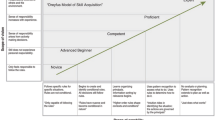Abstract
Designing and developing games for learning is a difficult endeavor. Educational game designers must not only make an engaging and motivating game, but must also ensure that learning takes place as a result of gameplay. Educational researchers have sought to define design principles in order to lessen the difficulty involved with game design. In spite of these efforts, there is still a paucity of empirical research in support of significant direct learning gains that result from time spent in a game environment. This study investigated the effectiveness of a design and development approach centered on playtesting, with the purpose of ensuring the proper intrinsic integration of multiplication properties, concepts, and strategies within the game’s mechanics.











Similar content being viewed by others
Explore related subjects
Discover the latest articles, news and stories from top researchers in related subjects.References
Ainsworth, S., & Loizou, A. T. (2003). The effects of self-explaining when learning with text or diagrams. Cognitive Science, 27, 669–681.
Ashcraft, M. H., & Christy, K. S. (1995). The frequency of arithmetic facts in elementary texts: Addition and multiplication in grades 1–6. Journal for Research in Mathematics Education, 26(5), 396–421.
Barab, S. A., et al. (2007). Relating narrative, inquiry, and inscriptions: Supporting consequential play. Journal of Science Education and Technology, 16(1), 59–82.
Becker, K., & Parker, J. (2014). Methods of design: An overview of game design techniques. In K. Schrier (Ed.), Learning, education and games: Volume one: Curricular and design considerations (pp. 179–198). Pittsburgh: ETC Press.
Denham, A. R. (2013). Strategy instruction and maintenance of basic multiplication facts through digital game play. International Journal of Game-Based Learning, 3(2), 36–54.
Devlin, K. (2011). Mathematics education for a new era: Video games as a medium for learning. CRC Press.
Fay, I. (2014). Playtesting and iterative design: The most important process for making great games. In K. Schrier (Ed.), Learning, education and games: Volume one: Curricular and design considerations (pp. 251–263). Pittsburgh: ETC Press.
Fullerton, T., Swain, C., & Hoffman, S. (2004). Game design workshop: Designing, prototyping, & playtesting games. San Francisco, CA: CMP Books.
Gee, J. P. (2004). Learning by design: Games as learning machines. Interactive Educational Multimedia, 8, 15–23.
Gee, J. P. (2005). Good video games and good learning. In Phi Kappa Phi Forum (Vol. 85, No. 2, p. 33). THE HONOR SOCIETY OF PHI KAPPA PHI.
Habgood, M. P. J., & Ainsworth, S. E. (2011). Motivating children to learn effectively: Exploring the value of intrinsic integration in educational games. Journal of the Learning Sciences, 20(2), 169–206.
Habgood, M. P. J., Ainsworth, S. E., & Benford, S. (2005). Endogenous fantasy and learning in digital games. Simulation Gaming, 36(483), 483–498.
Honey, M., & Hilton, M. (2011). Learning science: Computer games, simulations, and education. Washington: National Academies Press.
Kafai, Y. B. (2001). The educational potential of electronic games: From games-to-teach to games-to-learn. Retrieved July 12, 2011, from http://culturalpolicy.uchicago.edu/conf2001/papers/kafai.html
Koshmider, J. W., & Ashcraft, M. H. (1991). The development of children’s mental multiplication skills. Journal of Experimental Child Psychology, 51(1), 53–89.
Lemaire, P., Barrett, S. E., Fayol, M., & Abdi, H. (1994). Automatic activation of addition and multiplication facts in elementary school children. Journal of Experimental Child Psychology, 57(2), 224–258.
Li, M. C., & Tsai, C. C. (2013). Game-based learning in science education: A review of relevant research. Journal of Science Education and Technology, 22(6), 877–898.
Malone, T. W. (1981). Towards a theory of intrinsically motivating instruction. Cognitive Science, 5(4), 333–369.
Malone, T. W., & Lepper, M. R. (1987). Making learning fun: A taxonomy of intrinsic motivations for learning. In R. E. Snow & M. J. Farr (Eds.), Aptitude, learning and instruction III: Conative and affective process analyses. Hillsdale, NJ: Erlbaum.
Martin, T., & Schwartz, D. L. (2005). Physically distributed learning: Adapting and reinterpreting physical environments in the development of fraction concepts. Cognitive Science, 29(4), 587–625.
Miller, C. S., Lehman, J. F., & Koedinger, K. R. (1999). Goals and learning in microworlds. Cognitive Science, 23(3), 305–336.
National Governors Association Center for Best Practices & Council of Chief State School Officers. (2010). Common Core State Standards for Mathematics. Washington, DC: Authors.
Nelson, B., Ketelhut, D. J., Clarke, J., Bowman, C., & Dede, C. (2005). Design-based research strategies for developing a scientific inquiry curriculum in a multi-user virtual environment. Educational Technology, 45(1), 21–27.
Papert, S., & Talcott, J. (1997). The children’s machine. Technology Review, 96(5), 29–36.
Prensky, M. (2005). Computer games and learning: Digital game-based learning. In J. Raessens & J. Goldstein (Eds.), Handbook of computer game studies (pp. 97–122). Cambridge: MIT Press.
Reiber, L. P. (1996). Seriously considering play: Designing interactive learning environments based on the blending of microworlds, simulations, and games. Educational Technology Research and Development, 44(2), 43–58.
Salen, K., & Zimmerman, E. (2003). Rules of play: Game design fundamentals. Boston: MIT Press.
Shadish, W. R., Cook, T. D., & Campbell, D. T. (2002). Experimental and quasi-experimental designs for generalized causal inference. Boston: Houghton Mifflin.
Shaffer, D. W. (2006). How computer games help children learn. New York: Palgrave Macmillan.
Shute, V. J., & Ke, F. (2012). Games, learning, and assessment. In D. Ifenthaler, D. Eseryel & X. Ge (Eds.), Assessment in game-based learning (pp. 1–8). New York: Springer.
Squire, K., & Klopfer, E. (2007). Augmented reality simulations on handheld computers. The Journal of the Learning Sciences, 16(3), 371–413.
Tobias, S., & Fletcher, J. D. (2011). Computer games and instruction. Charlotte, NC: Information Age.
Van Eck, R. (2006). Digital game-based learning: It’s not just the digital natives who are restless. EDUCAUSE Review, 41(2), 16.
Wong, K. K. (1996). Video game effect on computer-based learning design. British Journal of Educational Technology, 27, 230–232.
Author information
Authors and Affiliations
Corresponding author
Rights and permissions
About this article
Cite this article
Denham, A.R. Improving the Design of a Learning Game Through Intrinsic Integration and Playtesting. Tech Know Learn 21, 175–194 (2016). https://doi.org/10.1007/s10758-016-9280-1
Published:
Issue Date:
DOI: https://doi.org/10.1007/s10758-016-9280-1




